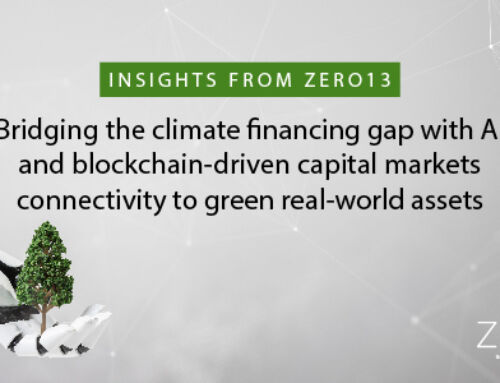Written by: Hirander Misra, CEO of ZERO13, and Lawrence Rufrano, Co-Founder of Secured Carbon
Creating a functional and efficient market is a complex task that requires a strategic blend of infrastructure, transparency, and trust. Whether developing a booming carbon credit market or a dynamic tax credit market, certain foundational elements are crucial for establishing a liquid, reliable, and sustainable marketplace. By examining the essential components of a well-functioning market and learning from the challenges experienced in the carbon credit sector, we can gain insights into how to develop a thriving ecosystem that supports the success of the evolving tax credit market.
The Role of Exchanges in Market Creation
At the heart of any successful market lies a well-regulated exchange. Exchanges serve as the central hub where buyers and sellers can come together, facilitating efficient and transparent transactions and price discovery. By ensuring that pricing information is accessible to all participants, exchanges reduce information asymmetry, fostering fair competition.
Beyond transaction facilitation, exchanges play a crucial role in maintaining market stability. They enforce rules and regulations that promote:
- Fair trading practices
- Reliable settlement processes
- Adherence to governance standards
- Smooth flow of capital between participants
These standards not only safeguard the market’s integrity but also protect against fraudulent activities. By requiring participants to comply with these standards, exchanges build and reinforce trust between issuers and investors, further enhancing the market’s reliability.
The Foundation of Exchanges: Transparency and Veracity
Pricing transparency is a fundamental pillar of an effective market. For a tax credit market, establishing a dedicated exchange would not only enhance disclosures regarding underlying projects and ensure compliance with tax regulations, but it would also grant all participants equal access to critical information. However, the availability of more information is only the first step in establishing the market value of a carbon or tax credit. Pricing transparency is equally critical. Transparent pricing mechanisms prevent market manipulation and ensure that prices accurately reflect the true value of the underlying assets. Participants need access to clear, real-time pricing information to make informed decisions, to maintain trust in the market and to encourage more active participation in the market.
Equally essential is veracity—the accuracy, reliability and truthfulness of information. In the carbon market, this means ensuring that the credits are legitimate and comply with all relevant regulations. Investors must have confidence that the information they receive is credible and that the assets they are trading are genuine and of high integrity.
Liquidity: The Lifeblood of Markets
Liquidity – the ease with which assets can be bought or sold without causing a significant movement in price – is essential for a healthy market. For tax credits, especially smaller ones, achieving liquidity can be challenging. This is where innovative strategies become essential.
One approach is attracting a wider range of participants beyond institutional investors including brokers, retail investors, family offices, and tax service providers. Additionally, exchanges can create an environment that reduces transaction costs, accelerates bidding, and ensures the smooth closure of transactions. These elements of liquidity are essential for the efficient functioning of any market, as it allows participants to enter and exit positions with greater ease and confidence.
Pooling Mechanism: A Solution for Smaller Credits
Given that 80% of the tax credit market consists of credits less than $50 million, a pooling mechanism becomes crucial. By aggregating smaller credits together, we can create more attractive investment vehicles that are easier to trade and manage. This strategy not only increases liquidity but also opens up the market to a wider range of investors, enhancing market participation. Additionally, pooling enables diversification which mitigates the risk associated with individual credits and creates more stable, attractive opportunities for investors.
Ratings and Standardisation are the First Steps Towards Aggregation
In markets where products are non-standard and sometimes opaque financial instruments such as carbon and tax credits, ratings become a valuable tool for assessing the quality and risk associated with different assets. Ratings play a crucial role in non-standard products, providing a quick and easy way for investors to assess the quality and risk of a particular asset. In the context of tax credits, a rating system could evaluate factors such as the likelihood of the credit being honoured by tax authorities, the financial stability of the entity issuing the credit, and the overall risk profile of the investment.
As the market matures, we can expect to see increased standardisation, similar to what has occurred in commodity markets. This could lead to the development of structured products, ETFs, futures, and options based on underlying pools of tax credits. Standardised carbon or tax tokens also could be developed, representing a diversified basket of credits. Such innovations not only simplify trading but also create new opportunities for financial innovation, including the development of derivatives and more complex structured products. Such advancements would further enhance liquidity and provide investors with a broader array of ways to participate in the market.
Learning from Carbon Credits: Overcoming Friction
The carbon credit market provides valuable lessons on potential pitfalls to avoid. Challenges such as multiple registries with differing standards, evolving regulations, limited comparative information, and fraud risks have all contributed to friction in that market. To avoid similar issues in the tax credit market, we must focus on the following priorities:
- Unified standards: Establishing a single, comprehensive set of standards for tax credits.
- Stable regulatory environment: Collaborating with policymakers to develop a stable and predictable regulatory framework.
- Comprehensive information: Providing investors with detailed, comparable data across different tax credits.
- Fraud prevention: Implementing robust verification processes and leveraging technology to minimise fraud risks.
Key Components for a Successful Tax Credit Market
To overcome these challenges and create a thriving tax credit market, several key components should be considered:
- Pooling mechanism: Essential for aggregating smaller credits to achieve scale and improve liquidity.
- Rating system: Providing investors with a quick, reliable way to assess tax credit quality and risk.
- Insurance wrap: as an alternative to ratings, an insurance wrap on credit pools could provide additional security.
- Strong legal opinions: Critical for ensuring the validity and enforceability of tax credits.
- Data-based verification: Implementing a system where the same data submitted to the IRS is available to investors, enhancing transparency and trust.
Building a successful tax credit market requires careful consideration of multiple elements—from establishing exchanges and ensuring transparency to implementing pooling mechanisms and robust verification processes. By learning from the challenges faced in the carbon credit market and implementing innovative solutions, we can build a thriving ecosystem that benefits issuers, investors, and the broader economy.
As the tax credit market evolves, it will likely see the development of more sophisticated financial instruments, increased standardisation, and greater liquidity. With the right approach, these markets can develop into robust and efficient systems that drive investment and contribute to global sustainability goals. However, laying a foundation of trust, transparency, and efficiency is essential to long-term success. By focusing on these critical elements now, we can create a market that not only functions effectively but also drives economic growth and supports important policy objectives.





